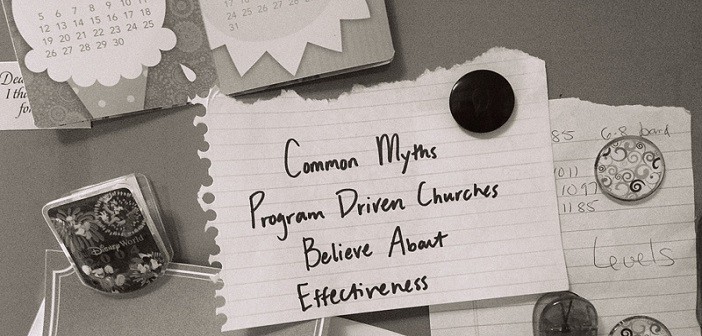Today’s churches offer church goers more programs than ever before. Whether it is activities for men or women, couples or singles, young adults or seniors, many churches find themselves drifting towards complexity as more and more ministry programs are added each year.
So what exactly separates churches overloaded with programs from those who have found a simpler way? I believe the answer lies in how each church thinks.
With this in mind, here are five common myths that program-driven churches believe about effectiveness:
Myth 1: The road to simplicity begins with a focus on meeting needs.
Churches are made up of different demographics each with their own unique needs. In an attempt to better understand and meet these needs, some churches choose to pursue a program-driven approach. Over time, the total number of programs offered in these churches naturally tends to grow. This happens whenever pressure mounts within these churches to expand the number of programs offered in order to address the unique needs of each demographic group.
Instead of asking “How can our church meet a person’s need,” a different question to consider asking is this— “How can our church create steps that move people along a path that leads them closer to where God intends for them to be?”
Myth 2: Higher levels of participation in programs is a sign of spiritual growth.
Churches oftentimes measure program effectiveness by attendance. When participation percentages are high, it can be natural to assume that spiritual growth must be taking place.
But that may not always be the case.
Whenever people invest their time into anything, it will always require trade-offs. The more time church goers spend attending church programs, the less time they have available to connect with those outside of the “four walls” of the church.
So could it be that high levels of participation in programs are indeed a result of maturing believers choosing to invest back into their local churches?
Possibly.
Or it may just simply mean that the people within these churches are increasingly becoming more and more insider focused.
Myth 3: Adding more programs strengthens ongoing member retention.
Some churches believe that a foundation for an effective member retention strategy is in a wide offering of church programs. While it is possible that adding more programs may lead to better retention numbers in the short term, long term problems may arise if the programs themselves become a primary reason that church goers have for staying. That’s because it will only be a matter of time before another church comes along offering bigger and better programs than yours.
A stronger way for churches to retain members is to clarify and consistently communicate their vision. The more that church goers understand the vision and the vital part that they play in helping to bring that vision to pass, the more likely they are to stick around.
Myth 4: If the people in our churches are pleased, God must be too.
Reducing the number of church programs would be so much easier were it not for the emotional attachments that people develop with them over time. Change can seem difficult when it means upsetting those who expect for the church to operate the way that it always has. The problem comes when churches assume that just because people are happy with the way that things are happening within the church, then God must be happy with things there too.
Here’s what I have come to realize.
There will always be a group of people you can never please no matter what you say or do.
That’s because any God-given vision will always attract some people and at the same time repel others.
And that’s okay.
What if God was most pleased with His church when they chose to pursue the vision that He had given them, even when it meant upsetting a few insiders along the way?
Myth 5: Programs develop genuine community within the church.
Genuine community develops over time as people openly share and speak into each other’s lives. Oftentimes, churches create programs with intentions to allow people to spend social time together; however, because of their design, many programs actually offer little opportunity to get to know the people attending beyond the event itself. Without organic and authentic conversations, several programs within a program-driven church have the potential to fall short of ever developing genuine community, leaving the people who attend them no more connected when they walk out than when they first walked in.
No church ever intends to become overloaded with programs. Yet far too many churches find themselves stuck in such a reality.
If you feel stuck, the good news is that things can in fact change for the better. But before you can ever achieve the next level of results, you must first begin to think differently.
Is your church overloaded with programs? Learn how The Unstuck Group‘s 4 Phase Planning Process can help you align church activity to vision.





